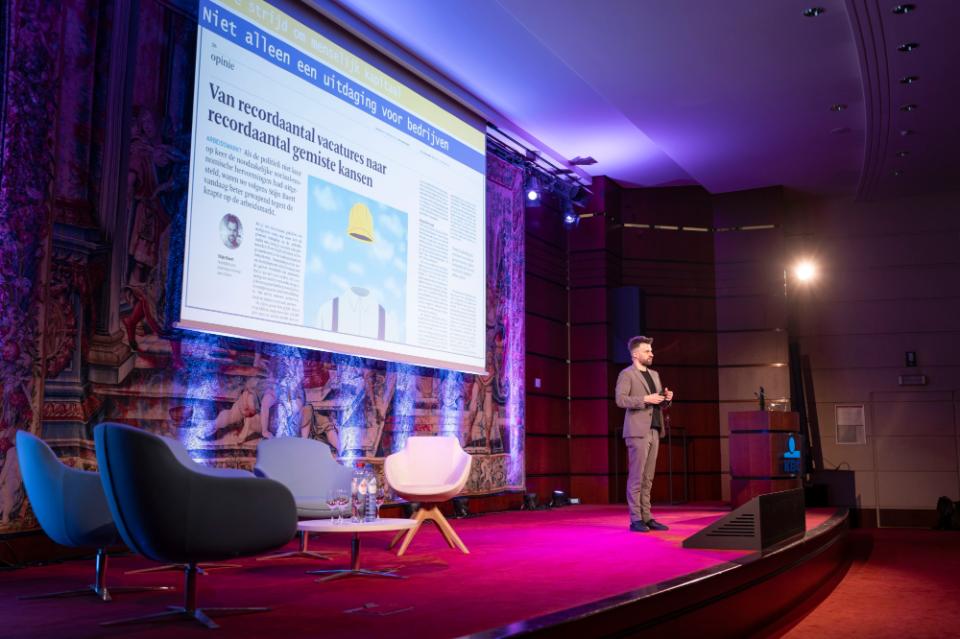In the absence of staff, people work here; treat them with care
During the recent labour market events organised by KBC, Stijn Baert, Professor of Labour Economics at Ghent University, gave an engaging keynote speech on the 'war for talent'. His presentation not only provided valuable insights, but also added important nuances and statistics to put the issues into context. Below is a summary of the main points.
The term 'war for talent' refers to the intense competition among companies to attract and retain the best and most talented employees. In an age of digitalisation and globalisation, talent has become the key to success, and companies need to invest in their employees more than ever. This competition results not only in higher salaries and extra benefits, but also in an increased focus on corporate culture and working conditions.
A puzzle that doesn't fit and a smaller pond

One of the key insights is the observation that the 'war for talent' is not a temporary phenomenon but a structural problem caused by both demographic changes and the evolution of the labour market. Together with an ageing population and a decline in the number of young people entering the labour market, this automatically leads to a reduction in the available talent. Companies must therefore prepare for a prolonged period of shortages of skilled workers.
However, there are a number of important caveats here. Not all sectors and companies are affected equally or equally badly. The Technology and Health Care sectors, for example, face a much more acute need for skilled staff compared to more traditional industries such as manufacturing or agriculture. There are also wide national differences, and even provincial and urban variation in Flanders, but Belgium is clearly struggling more than most other countries in the euro area.
This makes strong employer branding more important than ever in the bid to attract talent. Offering an attractive working environment and corporate culture is also key, as is investing in continuous employee development through training and education. By offering relevant and appealing training opportunities, companies can make their employees feel more engaged and retain them for longer.
Opportunities and threats for companies: The best vacancy is the one you don’t have to fill; in other words, the aim is to increase retention and attract candidates through a strategy of well-being at work. At the same time, offering employees more purchasing power, and thus demonstrating that they are valued, remains a strong incentive. For a single person in Belgium, no less than 53% of the wage bill goes to the Treasury; the figure in the Netherlands is 30%.
The push towards telecworking
The shift to teleworking is another important trend. Many companies have discovered not only the potential of teleworking, but also the benefits it offers, such as increased productivity, lower overheads and a better work-life balance for employees. International research shows that teleworking is greatly valued by employees, but there are also no indications that productivity is lower compared with similarly qualified employees. However, we have not yet struck the right balance, and teleworking is not yet sufficiently optimised to the nature of the business. Teleworking therefore does not come without challenges.
Opportunities and threats for companies: Increase retention and attract candidates by offering tailor-made teleworking opportunities, but take into account the employee's profile (proven 'conscientiousness'). It is also important to offer lifelong learning opportunities, as well as ensuring good-quality internal communication. Last but not least, it is vital to ensure that the organisation continues to facilitate work requiring concentration, among other things by preventing excessive online meetings.
A diverse labour market

A third important approach relates to diversity and inclusion in the workplace, something that is essential for innovation and growth. Diversity in terms of gender, age, ethnicity and background brings different perspectives and ideas to bear within an organisation, and that is crucial in a rapidly changing society. Companies with a diverse workforce are not only more innovative but also better able to respond to the needs of a diverse customer base. Embracing diversity can therefore pay dividends.
And research has also cleared up some misconceptions surrounding inequality. Discrimination is for example most commonly based on appearance, age and disability, with ethnicity coming in fourth place. Discrimination is also often driven by 'statistical discrimination', or rejection based on group characteristics (something that is also not permitted, incidentally). For example, people aged over 50 tend to be seen as ‘less flexible, less easy to train, less technologically skilled and more expensive’.
Professor Baert also stressed the importance of inclusion, with all staff feeling valued and engaged. Diversity and inclusion not only lead to better problem-solving and decision-making, but also to a more positive corporate image and greater appeal to a wide range of talents.
Opportunities and threats for companies: Workplace discrimination should therefore not be narrowed down to ethnicity or gender; a focus on age discrimination is equally crucial. There is thus a need for diversity in diversity policy. For example, companies can avoid candidate selection bias by using an 'evidence-based' selection process (one third CV and vacancy matching, one third validated texts, one third interviews to demonstrate crucial qualities, assessed by multiple selection officers).
Automation, digitalisation and AI
Robots, AI and other advanced technologies are taking over routine and repetitive tasks, allowing employees to focus on more strategic and creative work. However, this also requires employees to learn new skills and adapt to changing job requirements. Companies therefore need to invest in training and upskilling to future-proof their staff and ensure a smooth transition to a more automated working environment.
On a global scale, AI is likely to create more jobs, and automation also creates new tasks. It is important, however, that those new tasks keep pace with the speed at which AI and digitalisation are automating other tasks, and that there is a sufficiently large, well-trained workforce willing and able to perform those tasks.
Opportunities and threats for companies: The AI revolution will clearly not be good news for every worker, and AI also comes with a warning for diversity. For example, companies which currently use ChatGPT to screen job vacancies and applications might save time, but need be aware that the screening is based on 'existing perspectives'. Those are the same perspectives which led to non-European migrants being given fewer opportunities in the past.
Success in the modern labour market clearly depends on taking a proactive and flexible approach to talent management, with continuous development, diversity and inclusion at its core. Yet providing employees with more purchasing power will still always be seen as an important form of appreciation. At the employment event, a number of KBC experts therefore discussed the opportunities we as a bank-insurer offer to our employees in terms of extra mobility (bicycle, car, multimode, etc.), protection (health, well-being and pension schemes) and rewards (bonus, profit bonus, stock options, etc.).
Have any questions?
Disclaimer:
Unless expressly stated otherwise, all the information you consult or obtain here has a non-binding and purely informative value. It is updated to the best of our ability and at regular intervals. However, KBC Bank NV does not guarantee that this information is up-to-date, accurate, correct, complete or suitable for a particular purpose. The information provided here does not constitute advice or an offer to sell products or services and is not intended for commercial use. You remain fully responsible for the consequences of the use you make of this information. The intellectual property rights to the information, publications and data provided here belong to KBC Bank NV or third parties and you must refrain from any infringement thereof. Except with the express prior and written consent of KBC Bank NV, any transfer, sale, distribution or reproduction of this information is prohibited.
